On Harbor Boulevard, a pretense of business as usual
Though Orange County's Harbor Boulevard remains little changed, a history of unrest points to its potential to more positively engage with street life beyond the auto.
Click the blue mile markers above — or use the arrows — to take Christopher Hawthorne's guided tour of key sites along Harbor Boulevard.
Nov. 24, 2012
The protests that roiled Anaheim this summer had no regular home base, no Zuccotti Park or Tahrir Square. Instead, demonstrators angry over a series of shootings by Anaheim police marched on several days along Harbor Boulevard and a handful of other streets.
Yet there were moments when the rallies slowed — or were forced to pause — just long enough to resemble a traditional, stationary demonstration. One came on the afternoon of July 29, a Sunday, as 200 protesters walked south on Harbor from the Anaheim police headquarters toward Disneyland.
When they reached the intersection of Harbor and Ball Road, at the base of a modest rise that takes the boulevard over Interstate 5, they discovered a line of riot police and officers on horseback.
Over the next several minutes, as each side stared down the other, this wide Orange County crossroads, dominated on a typical day by cars and the trappings of car culture, revealed itself as a surprisingly useful public square.
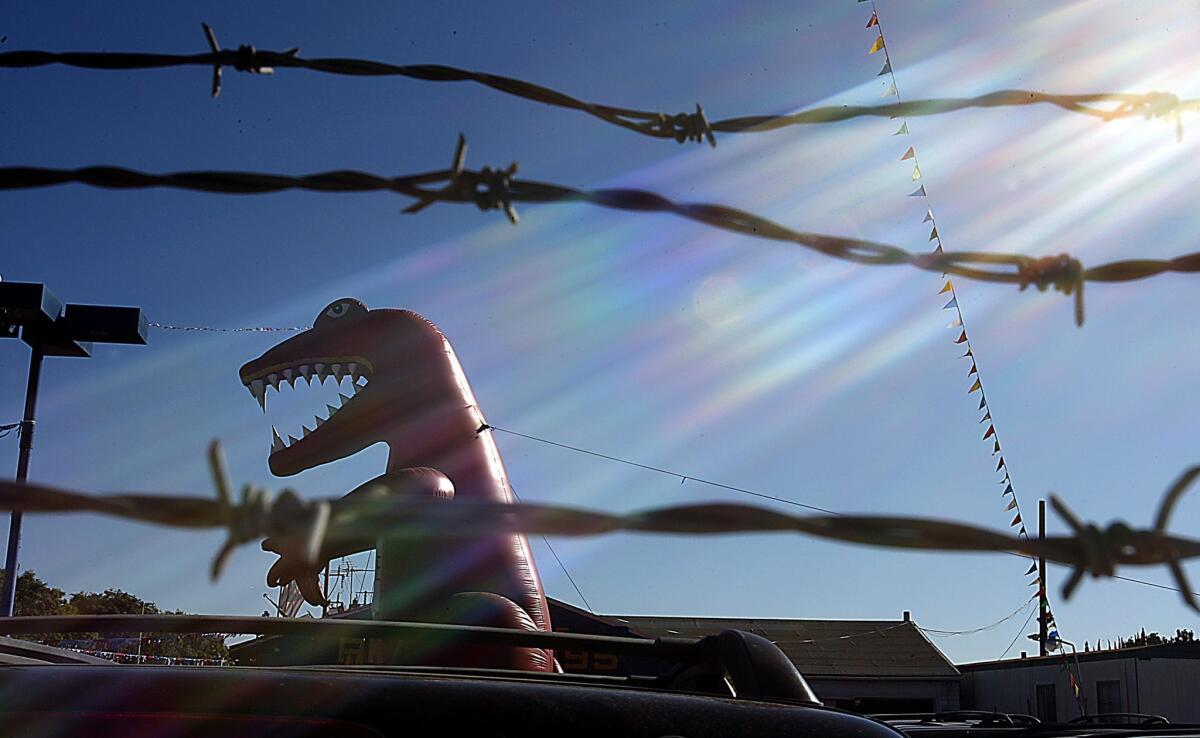
An inflatable dinosaur towers over one of the many used car lots along Harbor Boulevard in Santa Ana. (Luis Sinco / Los Angeles Times) More photos
The standoff was also very much in line with the rich if under-appreciated history of Harbor Boulevard, where street battles have played out for nearly a century.
Ku Klux Klansmen and the wives and daughters of striking citrus workers have played key roles in Harbor's most dramatic public spectacles. So have Abbie Hoffman's Yippies, who swarmed Disneyland in 1970 and planted a Viet Cong flag on Tom Sawyer Island.
These flash points have come irregularly, spasms of violence or protest theater on an otherwise buttoned-up boulevard. But the relationship between Harbor's physical character and its political history is closer than you might guess.
Harbor's architecture, largely anonymous and inward-looking, is marked by a studied blandness. Perhaps to make up for its shortage of impressive civic landmarks, the boulevard features a number of private spaces, including Disneyland, that look public but are in fact tightly controlled.
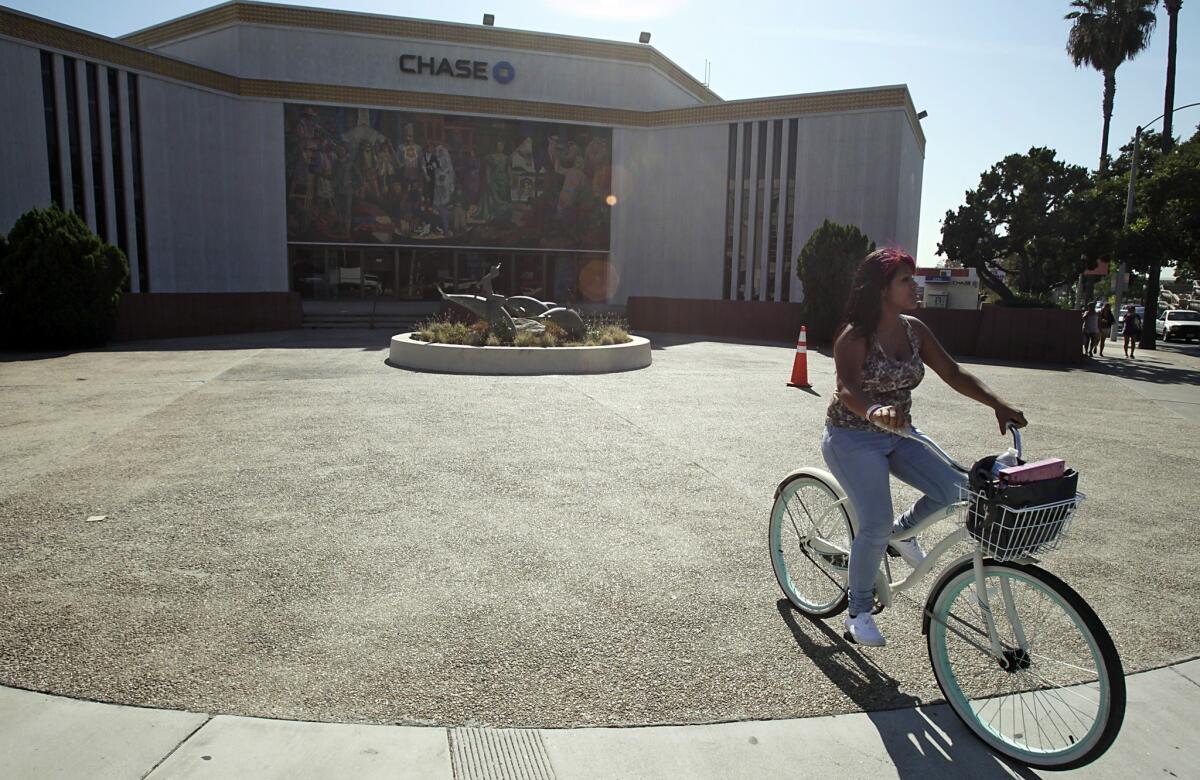
The Chase Bank building at the corner of Harbor Boulevard and Lincoln Avenue in Anaheim was originally a Home Savings built in 1970 and designed by architect and artist Millard Sheets. (Luis Sinco / Los Angeles Times) More photos
That recipe has produced on Harbor a feeling of unnatural civility — the architectural equivalent of a forced smile. And it has helped keep political tensions bottled up and out of view until they messily spill over, as they did during this summer's protests.
In that sense Harbor's history of turbulence has lessons to offer that have as much to do with urban design as politics. Like the CicLAvia bike festival and the recent tour of the Endeavour space shuttle, protest can open up new ways of looking at our streets.
It's on the extreme days, the unruly or topsy-turvy ones, that our boulevards show us most clearly what they might become. And Harbor continues to be very good at producing extreme days.
Though it covers 23 miles in all, Harbor Boulevard never quite makes it to the water. After running from the foothills above La Habra south through Fullerton, Anaheim, Garden Grove and Santa Ana, it peters out in the middle of Costa Mesa, two miles from the beach.
Harbor's name is therefore more aspirational than literal, and in that sense true to the spirit of Southern California expansion. So is the streetscape of the boulevard. With the exception of the area around Disneyland, where the sidewalks are generous and the tree canopy thick, Harbor is dominated by drive-throughs, auto-body shops, tire outlets and big-box stores.
And by intersections that are unusually wide: Crossing Harbor at Ball Road on foot means trudging across 10 shadeless lanes of traffic.
Even as the boulevards of Los Angeles have begun a remarkable transformation, opening themselves up to pedestrians and cyclists and chipping away at the dominance of the car, much of Harbor looks just as it did decades ago.
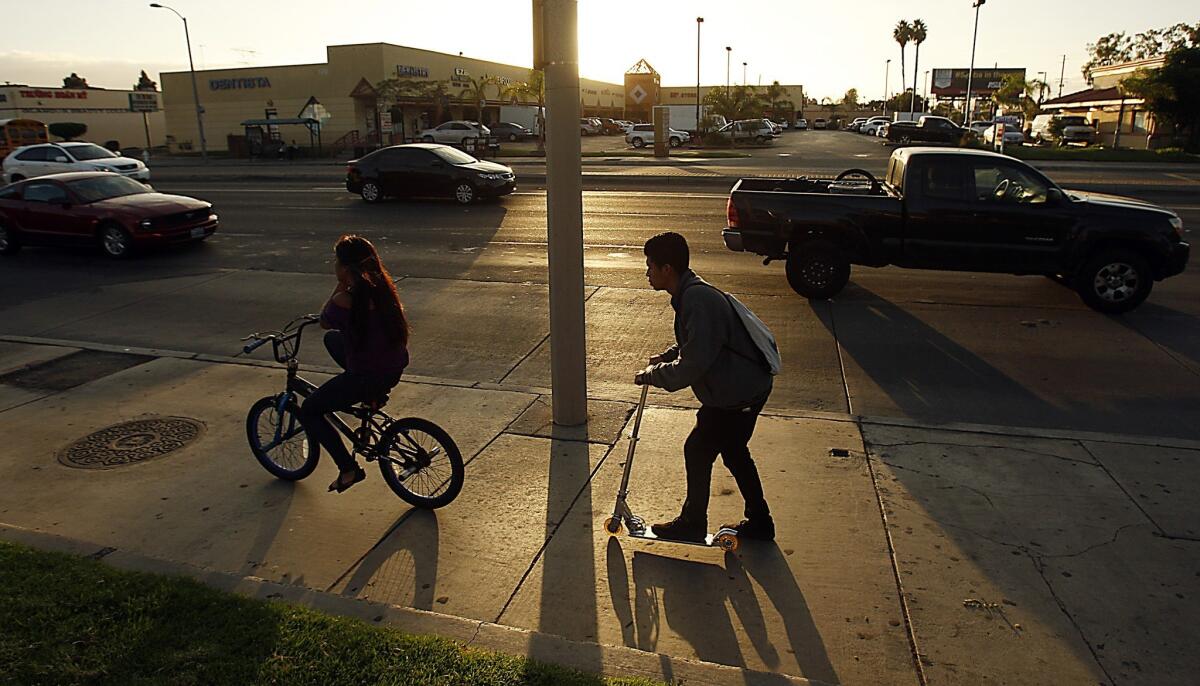
Kids scoot down Harbor Boulevard in Santa Ana as late afternoon traffic rolls along a landscape of strip malls. Despite real estate development, the boulevard has seen little change over the years. (Luis Sinco / Los Angeles Times) More photos
There is no equivalent on Harbor of the expanding light-rail network that is remaking Los Angeles. Although the Anaheim City Council has tentatively endorsed a streetcar system linking Disneyland with a planned transit center near Anaheim Stadium, for now — and for many years to come — the only rail service you'll see along this part of Harbor is the theme park's own monorail, which sweeps briefly into view on an elevated track.
In recent decades, the theme park has taken steps to seal itself off from the city around it. Caltrans added a dedicated offramp from Interstate 5, ending Harbor's traditional role as Disneyland's front door.
Anaheim, for its part, has slowly remade the stretch of Harbor that runs alongside Disneyland, homogenizing it in the process. In the 1990s, the city passed an ordinance requiring businesses near the park to replace their signs — some of them masterful examples of the space-age Googie style — with smaller ones meeting a uniform and remarkably bland design standard.
The new signs would no doubt please Walt Disney himself. Having chosen the location for his park with careful attention to demographics and traffic patterns — hiring the Stanford Research Institute to weigh the merits of several competing locations — he was dismayed by the motels that sprang up along Harbor and Katella Avenue in the years after Disneyland opened. Their kitschiness struck him as an affront to his meticulous planning and hermetic vision for the new theme park. And he kept them very much in mind as he planned Florida's Disney World in the 1960s.
"He was determined when they built Disney World not to make the same mistake he'd made in Anaheim," said longtime Orange County scholar Spencer Olin, a retired history professor at UC Irvine. "So in Florida they bought up as much land surrounding the new park as they could."
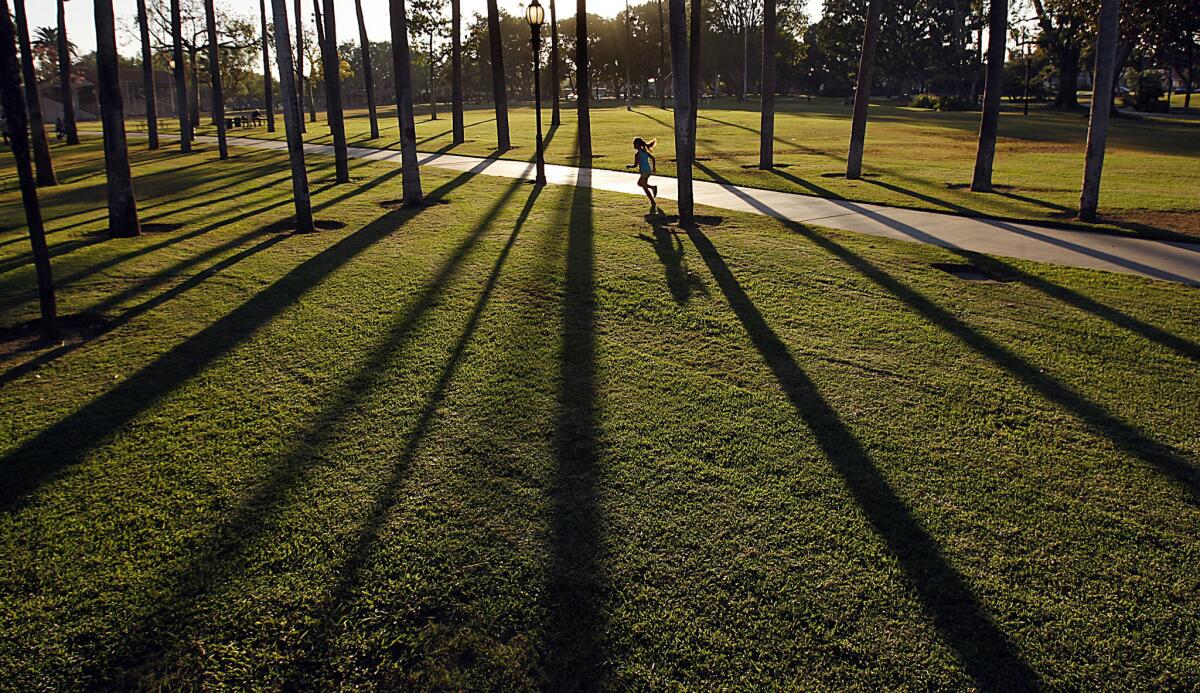
Pearson Park, on the corner of Harbor and Cypress Street in Anaheim, drew a nighttime Ku Klux Klan rally of reportedly 10,000 people in 1924, when it was known as City Park. (Luis Sinco / Los Angeles Times) More photos
Without that protective buffer in Anaheim, Disneyland has become a magnet for camera-ready protest. In 2008, hundreds of members of a union representing workers at three Disneyland hotels, many of them dressed as Disney characters, filled the intersection of Harbor and Katella, giving news photographers the chance to snap pictures of Cinderella and Mickey Mouse being dragged away in handcuffs.
But Harbor's political life predates Disneyland by several decades. Pearson Park, at the corner of Harbor and Cypress Street in Anaheim, was the site of a nighttime Ku Klux Klan rally in 1924 — when it was known as City Park — that drew a reported 10,000 people.
"Klan parades and public demonstrations were common to Anaheim in 1924," reads a report on the city's website, Anaheim.net. "On at least one occasion, Anaheim policemen had been seen directing traffic while wearing their white robe and hoods."
Violence even made its way into Anaheim's orchards. Hidden away near the corner of Harbor and Santa Ana Street is the small Pressel Orchard — the last remaining orange grove in a city once synonymous with the fruit.
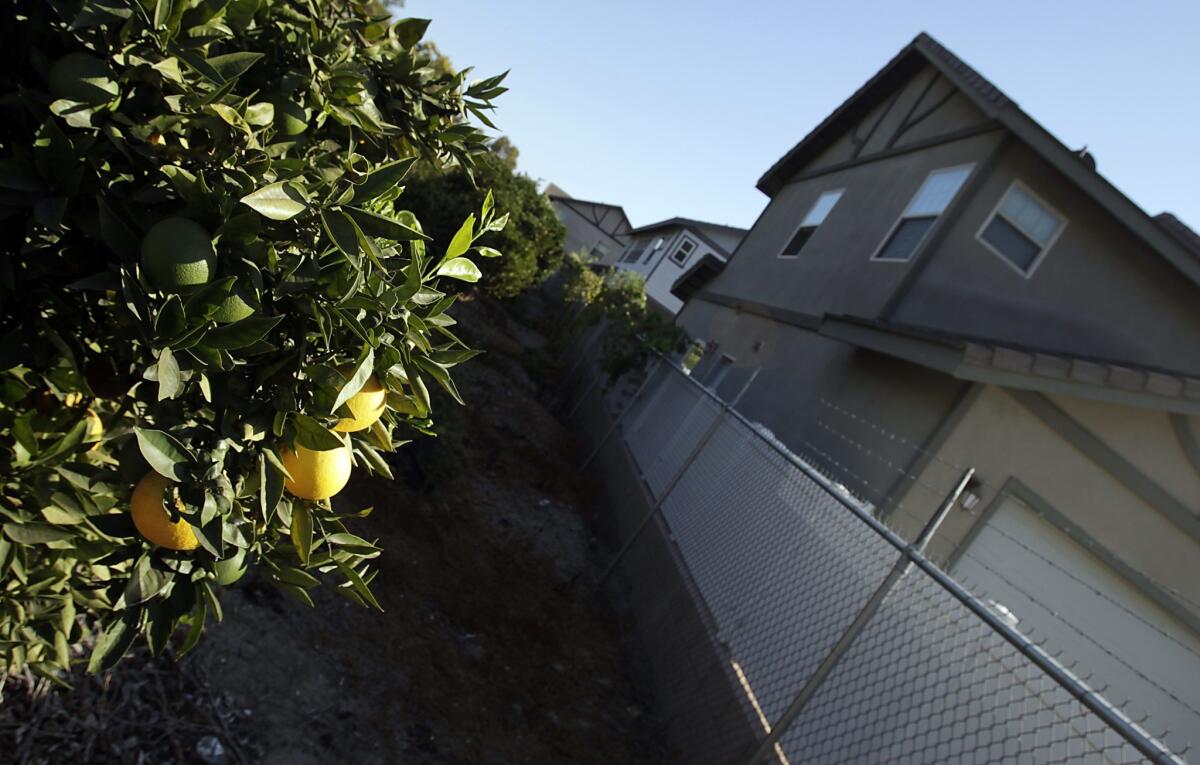
Anaheim was once synonymous with oranges; now, the only grove left standing is tucked away at Harbor and West Santa Ana Street. It's also the site of the first battle of the 1936 Citrus War. (Luis Sinco / Los Angeles Times) More photos
In 1936, when it covered significantly more ground than it does now, the orchard was the site of an early battle in the so-called Citrus War. Orange pickers had been striking for several days when they sent a group of their female relatives — about 200 women in all — to confront the replacement workers.
The Anaheim police swept in, and after one of the women bit an officer's arm the strike entered a new and volatile phase. The Citrus War raged for most of the summer before growers finally broke the strike at the end of July.
In part to compete with Disneyland, cities and developers in this part of Orange County have long chosen sites along Harbor to unveil their most ambitious — or outlandish — ventures.
Many have been built, including the massive Anaheim Convention Center complex and its under-appreciated arena, a soaring concrete shell designed by architect Adrian Wilson and finished in 1967. But most memorable are the proposed developments meant to mimic Disneyland's scale, or take advantage of its tourist hordes, that never got past the planning stage: a manmade river spanned by a replica of London Bridge, a giant cultural center in honor of Jordan's late King Hussein, who visited Disneyland in 1959 and 1981.
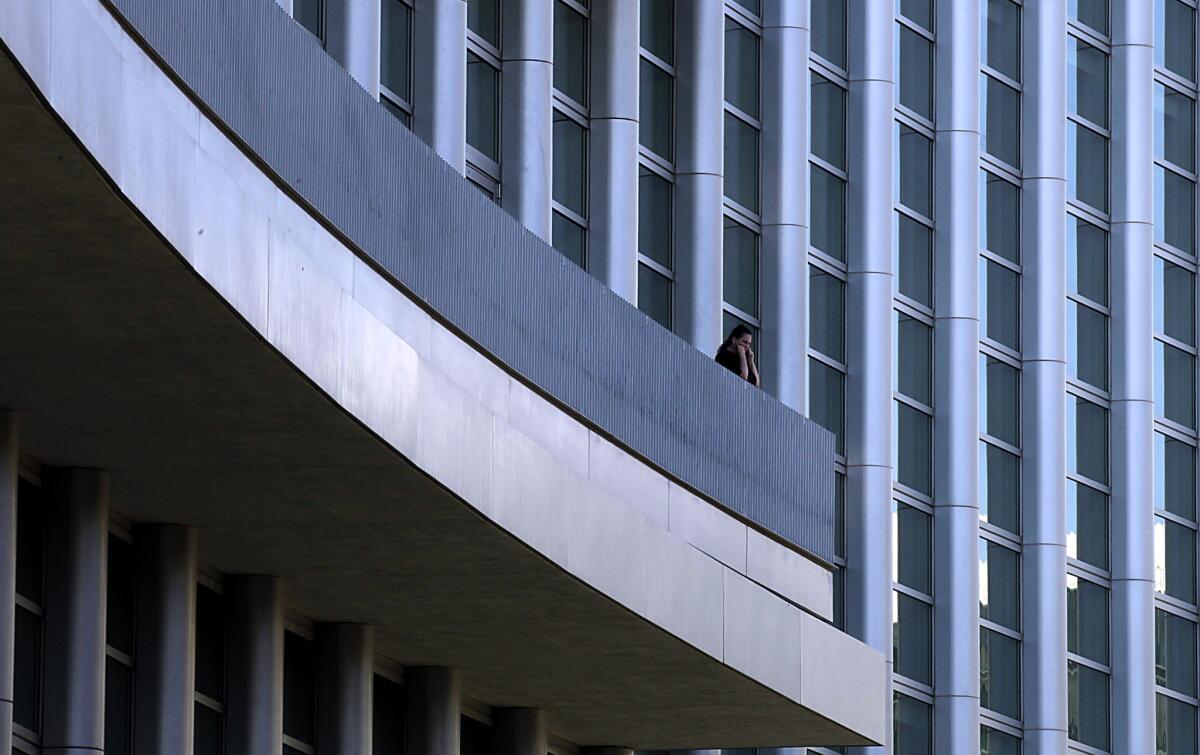
The metal and glass facade of the Anaheim Convention Center just off Harbor Boulevard dwarfs an office dweller. The boulevard is a vision of architectural extremes. (Luis Sinco / Los Angeles Times) More photos
A few miles south of the theme park, those ambitions fade. The boulevard, lined here by Salvadoran and Vietnamese restaurants, pool-supply stores and a handful of walled residential subdivisions, lets the facade of Magic Kingdom optimism noticeably slip. About four miles from the theme park, in a rundown Santa Ana strip mall alongside a taqueria and Lupe Gomez Income Tax, is a working-class Mexican bar with a tongue-in-cheek name: El Fracaso, or "The Failure."
"Some people say that on this part of Harbor you can pick up any kind of girl on the street at night," said Omar Munoz, who was celebrating his 21st birthday on a recent evening at El Fracaso, where the ceiling is low and the beer is sold out of plastic coolers lined up behind the bar.
The jukebox was blaring a song by the narcocorrido band Los Capos de Mexico, so he practically had to shout to be heard. "But it's really not a bad neighborhood. I grew up along here."
El Fracaso is a bit player in a larger battle in this stretch of Harbor between the sacred and the profane, between groups of churches and clusters of bars, strip joints and adult bookstores. Our Lady of La Vang, a Catholic church that fills nearly a full block, holds mass 11 times a week in Vietnamese, seven times in Spanish and once, for teenagers, in English.
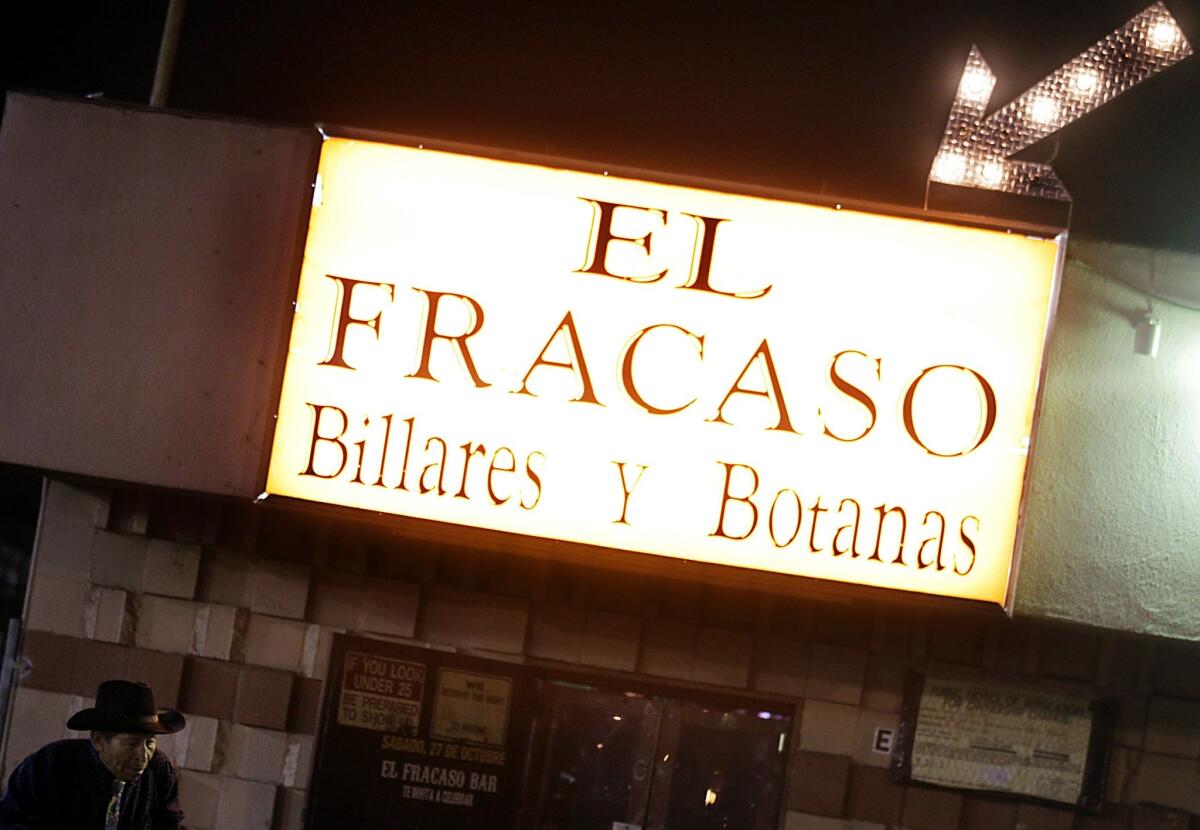
About four miles south of Disneyland, in a Santa Ana strip mall, is a working-class Mexican bar with a tongue-in-cheek name: El Fracaso, or "The Failure." (Luis Sinco / Los Angeles Times) More photos
At the southern end of Harbor, presiding over the wide intersection where it meets Newport Boulevard, is a 200,000-square-foot shopping center called Triangle Square. Its developer, Richard Shapiro, envisioned it from the start as more than a mere collection of shops and restaurants. In the tradition of Disneyland's Main Street USA, he dreamed it could be a stage for civic life, comparing its top-floor terrace to a "town square," a place "to hold blood drives or Little League sign-ups."
The complex struggled from its earliest days. Built in 1992 at a cost of $62 million, it was sold six years later for $47 million. Though the 24-Hour Fitness facing the parking garage on the bottom level is often crowded with people on treadmills and stationary bikes, the space up top is usually empty.
Still, the old dreams die hard. This summer the new owner of the property, Connecticut -based private-equity group Greenfield Partners, announced plans to invest $20 million to upgrade it, while renaming it "The Triangle."
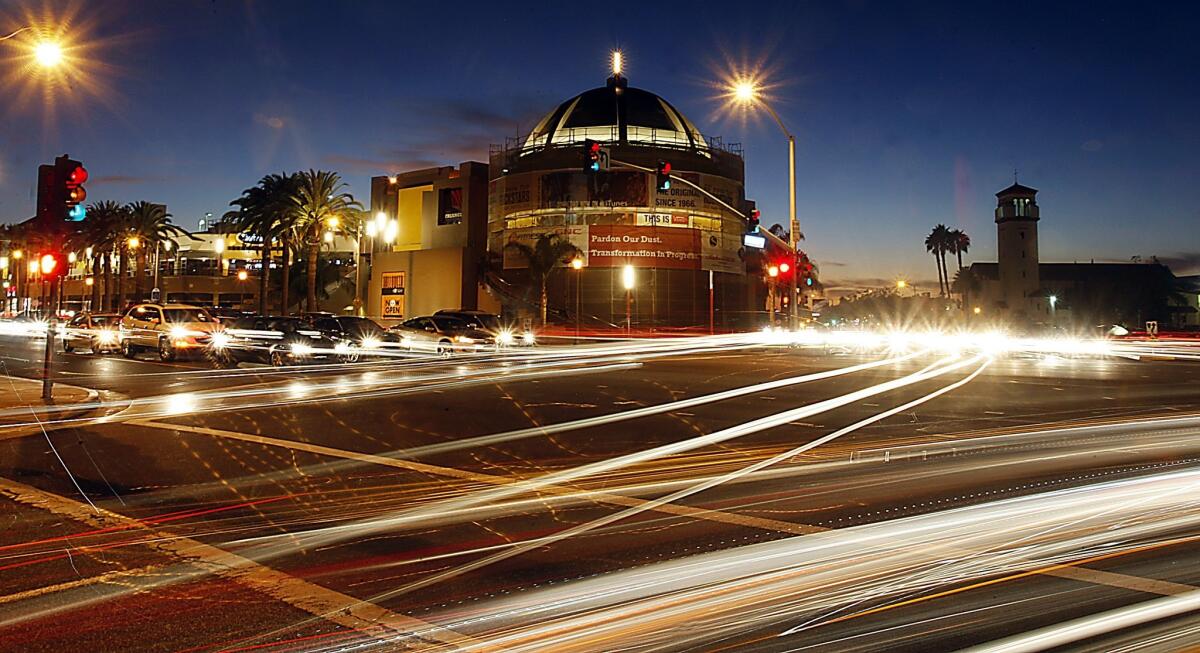
Triangle Square, at the southern end of Harbor Boulevard, is a 200,000-square-foot shopping center envisioned as a town square when built in 1992 but which has since struggled to fill space. (Luis Sinco / Los Angeles Times) More photos
That decision was hardly surprising given Harbor's history, said Gustavo Arellano, the cultural critic who is editor of OC Weekly and author of a memoir about growing up in Anaheim.
"When you compare Harbor to the other major boulevards in north and central Orange County, these other streets have no pretense to them," he told me as we drove south along Harbor on a recent morning. "But Harbor will always have this pretense of being more than it actually is."
In Garden Grove, we passed a large dirt lot that seemed to have appeared out of nowhere to illustrate his point. "That used to be a trailer park," Arellano said. "Now what are they going to build there?"
He craned his neck to read a sign trumpeting a new development as we drove by. "A 'water-park resort'? Yeah, right. I seriously doubt that."
Over the years the peculiar private urbanism perfected by Walt Disney has found some eloquent defenders. In "You Have to Pay for the Public Life," an essay on California's monumental architecture published in 1965, architect Charles Moore praised Disneyland as "the single most important piece of construction in the West in the last several decades," a place "engaged in replacing many of those elements of the public realm which have vanished in the featureless private floating world of southern California."
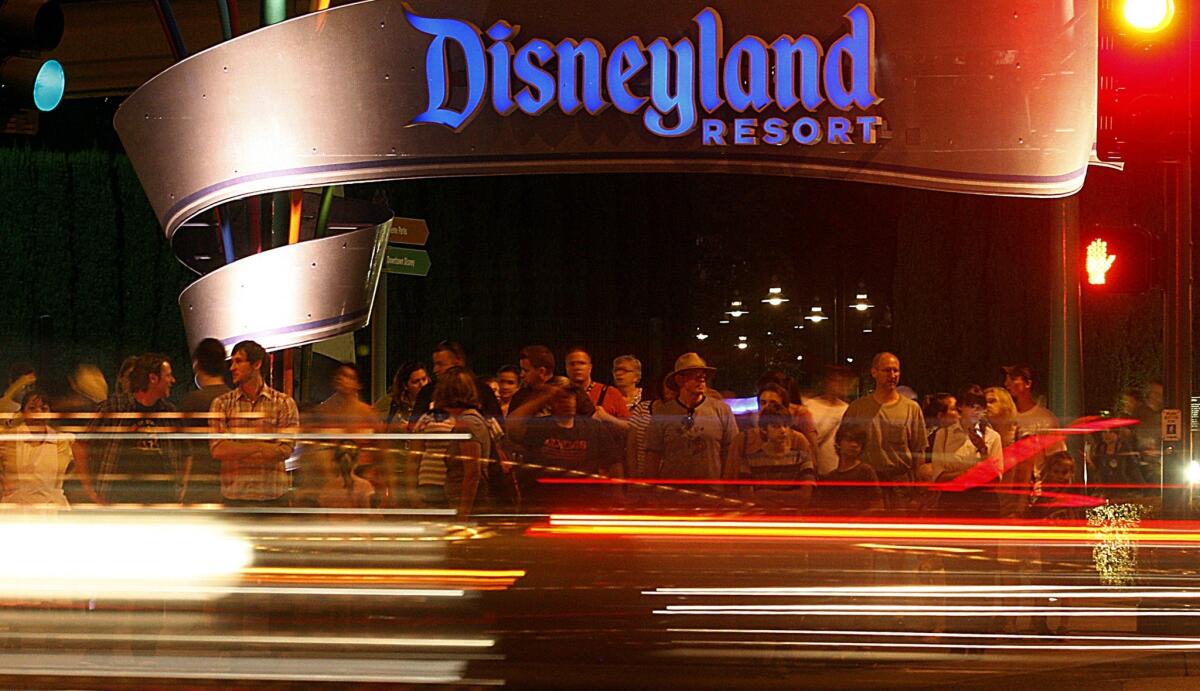
Disneyland visitors wait to cross Harbor Boulevard on its eastern side. The theme park has lived up to Walt Disney's aim to create a fantasyland hidden away from the metropolis around it. (Luis Sinco / Los Angeles Times) More photos
But even Moore acknowledged that Disneyland's version of urbanity, by exiling politics, had to be considered incomplete. By continually pushing political grievance to the periphery, Harbor Boulevard has in essence set itself up for periodic outbursts of the weird and violent.
An irony of the July 29 protest at Harbor and Ball was that the huge scale of the intersection, designed to make traveling by automobile as efficient as possible, lent some grandeur to the confrontation between demonstrators and police. The success of the space as an ad hoc public square was a reminder that our boulevards are full of potential hidden just below the surface — that they are capable of playing a far more important civic role than we tend to assume.
The afternoon standoff was not the most intense moment of this summer's demonstrations. That came on the night of July 24. Several hundred protesters threw rocks and bricks and started a series of small fires. Police responded by firing beanbag projectiles, bloodying several members of the crowd.
And then, from about two miles to the south, came a burst of light, illuminating the whole scene. It was the nightly fireworks show at Disneyland — going off as regularly scheduled, as if it were just another night on Harbor Boulevard.
Which, in a way, it was.
Explore: Atlantic Boulevard, Crenshaw and Sunset Boulevard with Christopher Hawthorne Los Angeles Times Architecture Critic.
christopher.hawthorne@latimes.com
Graphic credits: Paul Duginski | Programming: Anthony Pesce | Produced by: Lily Mihalik
Sources: ESRI, TeleAtlas



